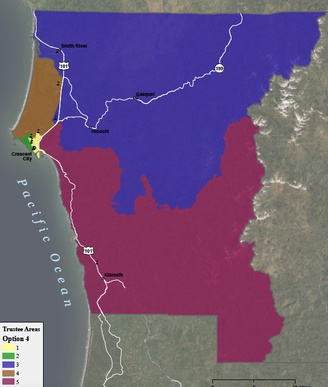Jessica Cejnar Andrews / Friday, Feb. 11, 2022 @ 4 p.m. / Education, Elections
Del Norte Unified, County Office of Ed Finalizes 'Districting' Process, Moves Forward With New Election Model for 2022

Del Norte Unified School District and County Office of Education's new election map has the same boundaries as the ones county supervisors approved in December. Courtesy of DNUSD
Previously:
• Del Norte Unified, County Office of Ed Seeks Public Input In Transition to Area-Based Elections
###
Del Norte County education officials completed the process that changes the way voters choose who they want to represent them on the local school board.
Starting in the Nov. 8, 2022 general election, voters living within Trustee Areas 1, 2 and 5 will cast a ballot for school board candidates residing in those trustee areas.
Three members of the Del Norte County Unified School District Board of Trustees, acting as representatives for the County Office of Education and the Del Norte County Committee on School District Organization, also chose a new election map Thursday with trustee area boundaries consistent with the map Del Norte County supervisors approved in December.
Trustees also had an opportunity to change the election sequence, but chose to keep it status quo, though Board President Don McArthur questioned this.
“The only comment I have ever heard about election sequencing, and this was somebody years ago who expressed to me, ‘Why do you elect three members in an off-year election as opposed to a presidential year election when you get more people showing up?’” McArthur said.
Trustees Angela Greenough and Jamie Forkner, who represent Trustee Areas 2 and 5 respectively, were absent.
The school board’s decision Thursday concludes a process that began in August when they approved resolutions of intent to move from a “hybrid at-large” election model spanning the entire county to trustee area-based elections.
The idea is for DNUSD and the County Office of Education, which share the same jurisdictional boundaries and policymakers, to avoid a lawsuit for potential violations of the California Voting Rights Act.
The California Voting Rights Act seeks to prohibit election models that could lead to diminishing the voting power of minority groups, according to Jonathan Berry-Smith, an attorney with the Walnut Creek law firm Lozano Smith.
DNUSD has been working with Berry-Smith and PlanWest Partners planners and demographers Colette Mettz and Jason Barnes to create its new election maps. The goal was to ensure an even distribution of population that didn’t deviate from each other by more than 10 percent.
According to Barnes, the election map DNUSD trustees chose on Thursday, which was the fourth of four options, had a total deviation of 8.2 percent.
DNUSD Superintendent Jeff Harris pointed out that the Board of Supervisors was required by law to go through the redistricting process. Trustees wanted to see how their counterparts representing Del Norte County acted so they could consider whether that map met other criteria set under the Voting Rights Act, Harris said.
“This is the first time in 50 or 60 years we’ve looked at this and for the district, this is a matter of districting for the first time,” Harris said. “This was a matter of due diligence using the Board’s own resources.”
DNUSD’s new election map drew approval from Del Norte County’s election official, Alissia Northrup.
“I think keeping the Board of Supervisor trustee areas the same as the school district is important,” she said. “There’s going to be a lot of change for voters as it is, going from an at-large (election). And also just considering that by the districts being different, this could be an increased cost to the school district for elections because it’s going to create more ballot types.”
Karen Sanders, who chairs the Del Norte County Republican Party and was on the county’s advisory redistricting committee, concurred with Northrup’s statement, saying it would confuse the public if the trustee areas for the school district were different from Del Norte County supervisor districts.
Answering McArthur’s question about why three seats are up for election during a mid-year election, which typically sees a lighter voter turnout, Berry-Smith said a decision to switch up election sequencing could lead to a vacancy.
“Usually these changes either result in a vacancy or sometimes it could be the person who’s supposed to be in office until 2026 voluntarily resigns and then run again in that different area,” Berry-Smith said.
Charlaine Mazzei, who represents Trustee Area 4, pointed out that this would be even more confusing to the public who are already used to the current election sequence.
“My feeling is if people care enough about voting for school board members, they will vote during the year that school board member is up for election,” she said. “And if they don’t care enough, they won’t regardless of whether it’s a presidential election or not.”
CLICK TO MANAGE